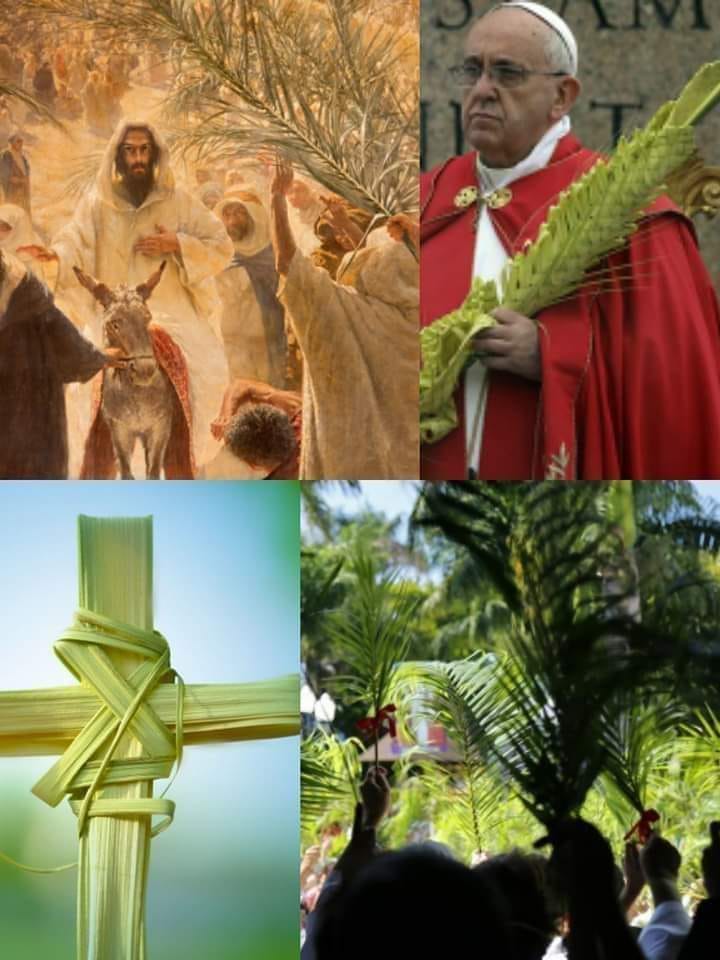John 12:13 So they took branches of palm trees and went out to meet him, crying out, “Hosanna! Blessed is he who comes in the name of the Lord, even the King of Israel!”
The implication of the Palms

Palms were symbols of life among the nomadic tribes, who, when crossing the desert, rejoiced at seeing the palm tree as it indicated an oasis with life-giving water was near. Palms have long been a sign of victory, success and glory. Victorious armies or leaders returning from the battlefield or a long military campaign were welcomed by the populace jubilantly waving palm branches. Despite Jesus’ peaceful manner, when the Jews waved the palms at Him and spread their clothing over which He rode, they were affording Him the honors of a conquering hero and simultaneously defying the Roman occupiers.
A brief history of Palm Sunday
As soon as the Church obtained her freedom in the fourth century, the faithful in Jerusalem re-enacted the solemn entry of Christ into their city on the Sunday before Easter, holding a procession in which they carried branches and sang the Hosanna (Matthew 21, 1-11). In the early Latin Church, people attending Mass on this Sunday would hold aloft twigs of olives, which were not, however, blessed in those days.
But such activity would not be possible until the fourth century when Constantine became emperor of the Roman Empire and ended all religious persecution. Later in that century, a Spanish pilgrim named Eigera visited Jerusalem. In her diary, she recorded how Christians re-created the events of Holy Week. She wrote that they gathered outside the city on the Sunday before Easter and listened to one of the Gospels telling of Christ’s triumphant entrance into Jerusalem.
Then they marched together through the city gates while carrying olive or palm branches. Our Palm Sunday processions are akin to what Eigera witnessed 17 centuries ago.By the ninth century, the procession with blessed palms had expanded beyond Jerusalem and during the Middle Ages became widespread throughout Europe. In the 17th century Christians were not only processing into church with palms but, during Mass, holding the palms while the Passion was being read.This Palm Sunday procession, and the blessing of palms, seems to have originated in the Frankish Kingdom.
The earliest mention of these ceremonies is found in the Sacramentary of the Abbey of Bobbio in northern Italy (beginning of the eighth century). The rite was soon accepted in Rome and incorporated into the liturgy. The prayers used today are of Roman origin.
A Mass was celebrated in some church outside the walls of Rome, and there the palms were blessed. Then a solemn procession moved into the city to the basilica of the Lateran or to Saint Peter’s, where the Pope sang a second Mass. The first Mass, however, was soon discontinued, and in its place only the ceremony of blessing was performed. Even today the ritual of the blessing clearly follows the structure of a Mass up to the Sanctus.
Everywhere in medieval times, following the Roman custom, a procession composed of the clergy and laity carrying palms moved from a chapel or shrine outside the town, where the palms were blessed, to the cathedral or main church.
Our Lord was represented in the procession, either by the Blessed Sacrament or by a crucifix, adorned with flowers, carried by the celebrant of the Mass. Later, in the Middle Ages, a quaint custom arose of drawing a wooden statue of Christ sitting on a donkey (the whole image on wheels) in the center of the procession.
These statues (Palm Donkey; Palmesel) are still seen in museums of many European cities.As the procession approached the city gate, a boys’ choir stationed high above the doorway would greet the Lord with the Latin song, Gloria, laus et honor. This hymn, which is still used today in the liturgy of Palm Sunday, was written by the Benedictine Theodulph, Bishop of Orleans (821):
Glory, praise and honor,O Christ, our Savior-King,To thee in glad HosannasInspired children sing.
After this song, there followed a dramatic salutation before the Blessed Sacrament or the image of Christ. Both clergy and laity knelt and bowed in prayer, arising to spread cloths and carpets on the ground, throwing flowers and branches in the path of the procession.
The bells of the churches pealed, and the crowds sang the Hosanna as the colorful procession entered the cathedral for the solemn Mass.In medieval times this dramatic celebration was restricted more and more to a procession around the church.
The crucifix in the church yard was festively decorated with flowers. There the procession came to a halt. While the clergy sang the hymns and antiphons, the congregation dispersed among the tombs, each family kneeling at the grave of relatives.
The celebrant sprinkled holy water over the graveyard, the procession formed again and entered the church. In France and England they still retain the custom of decorating graves and visiting the cemeteries on Palm Sunday.
The inspiring rites and ceremonies of ancient times have long since disappeared, only the sacred texts of the liturgy are still preserved. Today the blessing of palms and the procession (if any) are performed within the churches preceding the Mass. In America, Catholic, and some Episcopal, churches distribute palms to all the congregation.
The various names for the Sunday before Easter come from the plants used–palms (Palm Sunday) or branches in general (Branch Sunday; Domingo de Ramos; Dimanche des Rameaux). In most countries of Europe real palms are unobtainable, so in their place people use many other plants: olive branches (in Italy), box, yew, spruce, willows, and pussy willows. In fact, some plants have come to be called palms because of this usage, as the yew in Ireland, the willow in England (palm-willow) and in Germany (Palmkatzchen).
From the use of willow branches Palm Sunday was called Willow Sunday in parts of England and Poland, and in Lithuania Verbu Sekmadienis (Willow-twig Sunday). The Greek Church uses the names Sunday of the Palm-carrying and Hosanna Sunday.
Centuries ago it was customary to bless not only branches but also various flowers of the season (the flowers are still mentioned in the antiphons after the prayer of blessing).[35] Hence the name Flower Sunday which the day bore in many countries—Flowering Sunday or Blossom Sunday in England, Blumensonntag in Germany, Pasques Fleuris in France, Pascua Florida in Spain, Viragvasarnap in Hungary, Cvetna among the Slavic nations, Zaghkasart in Armenia.
The term Pascua Florida, which in Spain originally meant just Palm Sunday, was later also applied to the whole festive season of Easter Week. Thus the State of Florida received its name when, on March 27, 1513 (Easter Sunday), Ponce de Leon first sighted the land and named it in honor of the great feast.In central Europe, large clusters of such plants, interwoven with flowers and adorned with ribbons, are fastened to the top of a wooden stick. All sizes of such palm bouquets may be seen, from the small children’s bush to rods of ten feet and more. The regular palm, however, consists in most European countries of pussy willows bearing their catkin blossoms.
In the Latin countries and in the United States, palm leaves are often shaped and woven into little crosses and other symbolic designs. This custom was originated by a suggestion in the ceremonial book for bishops, that little crosses of palm be attached to the boughs wherever true palms are not available in sufficient quantity.Through the centuries, Palm Sunday and the procession of people holding palms would be celebrated in a variety of ways. In some locations the Blessed Sacrament was part of the procession, in other places the congregation started in the parish cemetery and then went into the church. Palms were sometimes blessed in one church and the people, carrying the palms, marched to another church for Mass. Most typical was the blessing of the people and the palms at a place outside the church and then processing in. For some time, even through the middle of the 20th century, the priest wore red vestments during the palm blessing and procession and then changed to a violet garment for Mass.
In 1955, the Church standardized and simplified the different entrances used on Palm Sunday: either an organized procession that begins somewhere outside the church, a solemn procession starting inside the church, or no procession at all. An entrance procession beginning at a location outside the church is used only once during the weekend Masses; it is not repeated at every Mass.
The Church calls this day Palm Sunday of the Passion of the Lord.
From Simply Catholic and Catholic Culture
Toby Kenobe

